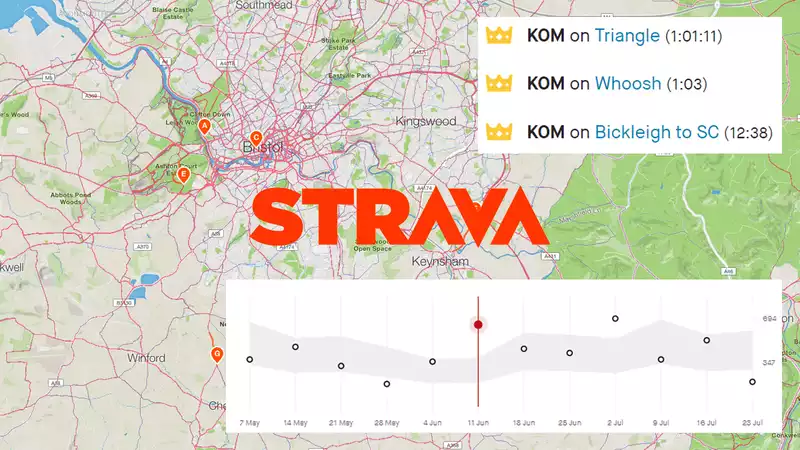Strava today announced the latest in a series of updates that it says are the most significant changes to its cycling app since its creation in 2009. The app's most distinctive feature, the KOM/QOM leaderboard, will be a subscription-only feature starting today.
In an open letter to the community, Strava founders Mark Gainey and Michael Horvath write about their plans to "put subscriptions at the heart of Strava" but will "always offer a version of Strava for free."
As part of its latest update, Strava has also simplified its subscription model, improved training metrics, and overhauled its website-based route builder tool.
In response to the rise of gravel as a cycling discipline, Strava's route builder now overlays popular heat maps and includes road surface types for those seeking (or avoiding) roadless roads.
Strava discontinued the Summit brand and the Training, Safety, or Analysis package subscription model introduced in 2018. Instead, it returned to a single paywall, whereby users could either subscribe or not.
Strava's new pricing structure consists of an annual subscription of £47.99 ($59.99, €59.99, A$81.99), which equates to £4.00 ($5.00, €5.00, A$6.83) per month. There is also a £6.99 ($7.99, €7.99, AUD$10.99) per month subscription. There is also an unprecedented two-month free trial of Strava's paid subscription for new users and current users of the free platform.
As of today, only the top 10 KOM/QOM leaderboards are visible to non-paying users. The rest of the leaderboard, along with past efforts of individuals, will be placed behind a pay wall.
Free Strava users can explore, create, flag, and search segments as well as view PRs and CRs. However, if you want to analyze past efforts, compare results, or view results outside of the fastest top 10 (all-time/women), you must subscribe.
In response to the growing popularity of gravel bikes, Strava has revamped its web-based route creation, adding heatmaps and road surface types to the tool.
Strava has long used its active user base to offer "popularity routing," but with its latest update it has taken this a step further, using a data set of 3 billion activities by over 55 million active athletes, Strava overlaid the basemap with a heat map. This means that users can manually create routes, referencing the most common or popular roads, trails, and gravel paths.
Strava's addition of road surface types is less detailed than its route planning rival, komoot, which only switches between paved, unpaved, and unknown roads. But it is on unknown surfaces where Strava finds an advantage: like Komoot, OpenStreetMap is used for its vastness and accuracy, but when the type of surface is unknown, Strava uses its vast data to infer the surface based on the equipment the athlete is using It tells Cyclingnews that it will look into it.
"As you know, members can add bikes, they can add shoes. We look at all of that data to guess whether it's dirt or road based on the type of bike people might be riding," explained Simon Klima, Strava's UK leader
.
In addition, Strava's Segment Explorer has also been incorporated into the route builder itself, much to the delight of KOM/QOM hunters, who now have a route builder that can be used to find out what type of bike people are riding.
This overhaul of Route Builder follows recent updates and improvements to in-app route creation and planning; the late March launch coincided with the COVID-19 craze, and as the shutdown triggered an indoor cycling boom, news somewhat though it resulted in news flying under the radar. 27]
In the Strava app, the [Summit] tab became the [Training] tab and focused on Strava's Relative Effort calculation to provide personalized analysis. The Training Dashboard now displays all Strava-supported activity types, not just run, ride, and swim, and is organized in four modules: weekly activity, training log, weekly intensity, and monthly fitness It consists of four modules: Weekly Activity, Training Log, Weekly Intensity, and Monthly Fitness.
Runners will be familiar with Strava's Matched Run feature, which provides an additional analysis available to compare two activities side-by-side if they complete the same course as their last run. Matched Ride is a recreation of this feature for cyclists. Both are available to subscribers only.
To take advantage of the two-month free trial, go to Strava (opens in new tab) and view Strava's open letter to the community.
.

Comments